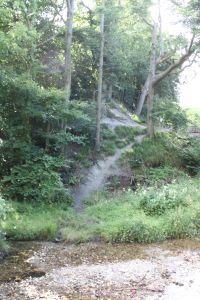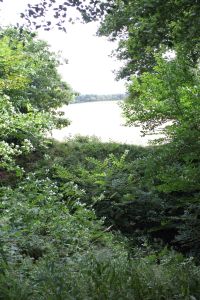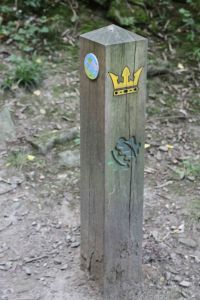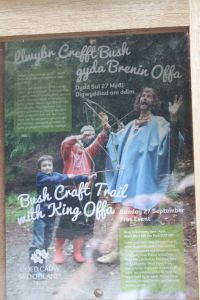


I have a long-standing interest in early medieval kingship, kingdoms and communities and their monumental expressions, but very little time and effort spent thinking about and exploring linear earthworks. Hence, my recent conference presentation and ongoing research on Offa’s and Wat’s Dykes in the vicinity of the Vale of Llangollen is a new departure for me. I also confess that I have traversed only minor stretches of either dyke and I have little interest in walking its length (where it is possible) simply for leisure.

I recently went to Nant Mill for the first time. Later, I returned and I explored a short stretch of Offa’s Dyke where it crosses the Clywedog in Plas Power woods and I learned a couple of new things about the monument.
I approached from upstream (from the west) and hence I encountered the earthwork within dense woodland as it followed a steep ravine down to join the Clywedog on its northern bank. The monument looms, like a celebrity, familiar and yet distinct in this context. There is something eerie about seeing something one recognises in a place one hasn’t been before. What specifically did I learn by doing this? I learned;
- how the monument operates to block and frame movement;
- how the monument makes subtle use of the existing topography;
- how the monument does exist on valley bottoms where circumstances allow its survival.
I also learned some practical things about appraising the monument. I learned:
- To photograph the dyke in woodland and on steep slopes is truly near impossible
- How panoramic shots are better than standard photographic focal lengths.
In both practical and intellectual terms, my previously stated point still stands: Offa’s Dyke is often just too big to apprehend and comprehend. I clearly have far more thinking to do about this monument and look forward immensely to the new book by Keith Ray and Ian Bapty on the subject.
There is also a heritage point to be made. The line of Offa’s Dyke here hits Plas Power woods: a tract of wooded valley managed by the Woodlands Trust and of significance for its industrial heritage, its use as a recreation area for local communities. There have been efforts to connect history and conservation. There is also a wooden sculpture of King Offa close to the monument bearing his name. For me, it is the linkage to local communities and these linear earthworks that fascinates me, more than their significance as long-distance footpaths, often going nowhere close to the early medieval monuments.






Offa’s Dyke in Nant Mill and Ruabon provides a better vantage point for the Welsh side and Watts Dyke gives a better view of the Welsh hills. It must be our Hadrian’s Wall.